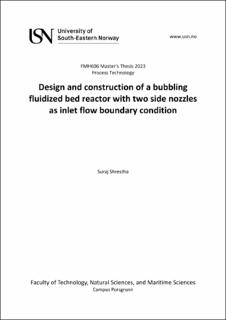| dc.description.abstract | Fluidized bed reactors are commonly used in industrial applications such as waste to energy conversion, chemical synthesis, granulation, catalyst regeneration, biomass gasification, pyrolysis, etc. They are used in such applications due to their efficient mixing, uniform heat, and mass transfer and better temperature control. Gas distribution inside the reactor plays a crucial role in determining the conversion process and fluidization regime. The air distributor plate is the most common method of gas distribution. However, it has drawbacks such as increased auxiliary power requirements and frequent cleaning and maintenance due to clogging of pores by sintering and small particles. As an alternative, fluidizing the particle bed with a nozzle helps overcome air distribution problems.
This study focuses on the construction of bubbling fluidized bed reactor with two side nozzles as inlet flow boundary conditions. The results of the bubbling fluidized reactor with side nozzles are compared with the bubbling fluidized bed reactor with distributor plate. This is done by studying the flow behavior of binary mixtures of Geldart B and Geldart D particles through a series of experiments. A Computational Particle Fluid Dynamics (CPFD) model was developed using EMMS-Yang-2004 drag models in Barracuda Software and validated using experimental data.
The results indicate that the reactor with two side nozzles has lower fluidization velocity than the reactor with distributor plate. The results also show that as the percentage of biomass increases in both reactors the minimum fluidization velocity decreases. In both reactors, good mixing of biomass and sand particles was observed after fluidization, and segregation of binary mixture was observed at a higher superficial gas velocity. Good mixing of binary mixture decreased on increasing biomass percentage in sand particles. Biomass segregates from the middle part of reactor with side nozzles whereas particles segregate from the bottom end of the reactor with uniform distribution. Mostly larger Bubbles were seen from the sides of the reactor after fluidization in the reactor with side nozzles. However, smaller bubbles were seen all over the reactor bed with the distributor plate reactor. | |
